Clear glass starts out annealed and then can then be tempered to increase its strength and safety characteristics.
Glass shelves for normal residential applications do not need to be tempered (but see exceptions below). In commercial applications (retail stores, restaurants, beauty salons, etc, tempering is highly recommended.
Table of contents
How is annealed glass made?
Most architectural glass is manufactured by melting silica sand, soda ash, dolomite, limestone, and sodium sulfate to 1480 degrees C, and then floating it on a pool of molten tin. (this is why it is referred to as “FLOAT” glass and not the old term “PLATE“). The glass passes, on a conveyor, through an annealing lehr – a furnace that controls the cooling process. The flat, cooled, solidified material at the end of the process is annealed glass. This is cut into sheets and shipped to other factories where secondary processes, like polishing, drilling, laminating and tempering, are applied.
How does annealed glass become tempered?
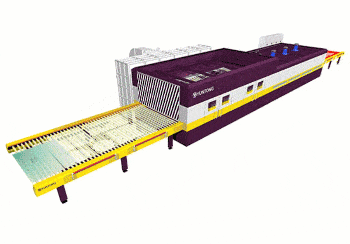
After the glass is cut to size it is passed, on rollers, through a tempering oven which heats it to a temperature of 620 degrees C.
Note that this diagram above is a repeating animated gif – the glass only goes through the tempering process once!
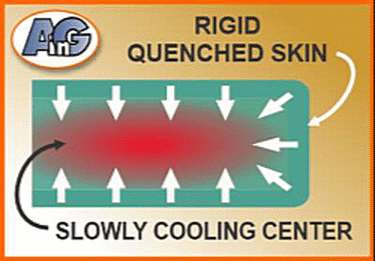
In the tempering oven, the hot glass is quickly “quenched” by high-pressure air from an array of nozzles. Quenching cools the outer surfaces of the glass much more quickly than the center. As the center of the glass cools, it tries to pull back from the rigid outer surfaces. As a result, the center remains in tension, and the outer surfaces go into compression, giving tempered glass its strength.
As an Amazon Associate, I earn from qualifying purchases
Comparison of key features of annealed and tempered glass
Load
Strength
Annealed
Surface compression about 2500 psi
Tempered
Surface compression > 10,000 psi
Impact
Strength
Annealed
Will break when hit by a hammer
Tempered
About 5 times more impact resistant
Safety
Annealed
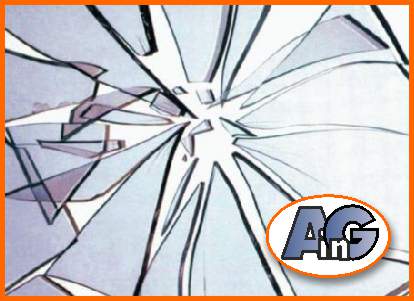
Tempered
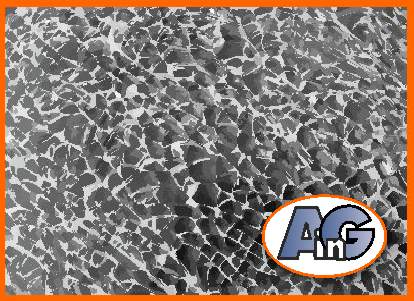
Fabrication
Annealed
Can be drilled, polished, notched, or grooved
Tempered
Must be drilled, polished, notched, or grooved before tempering
Thermal
Strength
Annealed
Low – cracks with temperature differences of +/- 60 deg F
Tempered
High-resists temperature differences of 200-300 deg. F
Spontaneous
breakage
Annealed
Never breaks spontaneously
Tempered
Possible – but very rare (sometimes due to conclusions)
Color
Density
Clarity
Reflectance
Annealed
No difference
Tempered
No difference
Typical
uses
Annealed
Residential windows, cabinet doors, indoor tabletops, most shelves
Tempered
Tub and shower enclosures,
patio doors and entry systems, fire resistant applications
Breaking of Tempered Glass
We create an attractive “Cracked Glass” tabletop by deliberately breaking a piece of 1/4″ thick tempered glass which is sandwiched between two pieces of 1/4″ annealed glass. The release of stress as the outside surface is penetrated results in the explosive creation of numerous harmless “popcorn” fragments. The completed tabletop has a total thickness of 3/4″.
Conclusions: for glass shelves – to temper or not to temper?
As shown in the table above, the crucial differences are the extra strength and safety of tempered glass and, to a lesser extent, the extra cost. So the decision on tempering depends mainly on the requirement for strength and the toleration of risk. The following two categories can be identified:
Retail/Restaurant Settings – Tempering Recommended
In a commercial setting, where customer safety is a prime concern, tempered glass is strongly recommended, especially in high-traffic areas. The modest additional cost is well worth the peace of mind and avoidance of costly insurance payouts. Furthermore, the extra strength translates into longer shelf life.
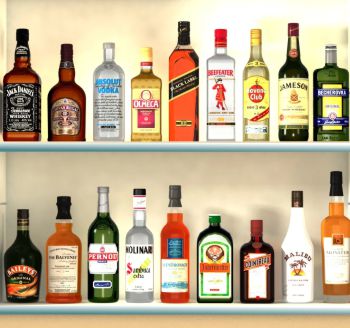
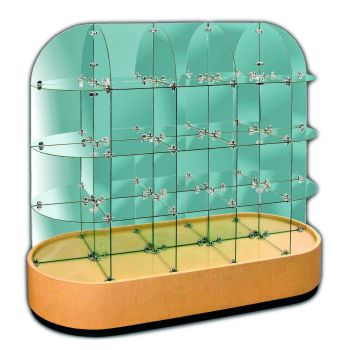
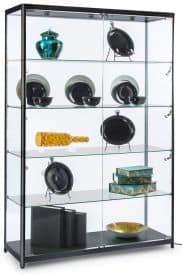
Heavy glass shelves in restaurant bars are tempered for strength and safety
Thin (5/32″) glass in “cubic” retail display case. Glass is tempered for strength and safety
3/16″ tempered glass is used in doors and shelves in this retail display cost.
Residential settings – tempering not normally necessary
Most display shelves in homes can safely be made of annealed glass although there are several exceptions to this rule including thin (5/32″) shelving – that requires tempering for strength.
Great deals are available on glass shelves from Amazon – if you can use standard sizes. These 3/8″ thick shelves are tempered and come with supports in several metal finishes
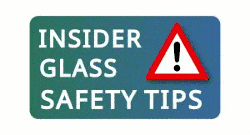
Use commonsense at all times!
Artistry-in-glass.com cannot be responsible for the consequence of decisions made on the basis of information contained in this blog post. Always use caution and choose tempered glass if there is any chance of children, family members or pets coming into violent contact with glass. Consult a glass professional when in doubt.
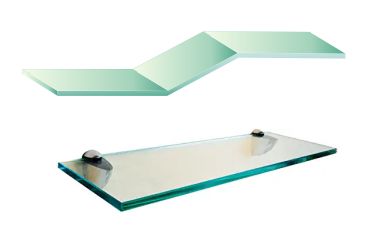
Special shapes and imported shelves
Imported glass shelving or special glass shelving like bent glass are always tempered because the extra strength will safeguard the glass against breakage due to impacts during shipping.

Are you displaying priceless treasures?
There is a very remote but nevertheless real possibility that tempered glass will spontaneously break and disintegrate into numerous small fragments. So although tempered glass is generally stronger than annealed glass it is not recommended to support collectibles which are extremely valuable or irreplaceable. For complete peace of mind use extra thick (1/2″ or 3/4″) annealed glass.

How can you Identify Tempered Glass?
Tempered glass looks identical in almost every way to annealed glass but it cannot be cut, drilled, or notched without breaking into thousands of pieces. Follow this link to learn everything about tempered glass or read on to learn how to tell if your pane of glass is tempered.
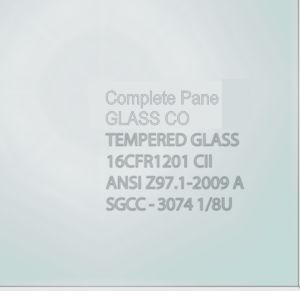
Tempered glass is identified by a small, sandblasted or acid-etched logo (called a bug in the glass business) which includes the ANSI (American National Standards Institute) number Z97.1. The bug must be permanently etched into the glass, in compliance with federal regulations and is placed in the corner of the glass panel. It may be hard to see because it is small (less than 1″ across).
If you cannot find a logo – study the edges of the glass
The edges of tempered glass may be polished or seamed but they are never sharp and clean-cut.
Test the surface with a glass cutter
Do not try this at home, but a glass professional can tell the difference by attempting the score the suspect sheet of glass with a glass cutter. If the glass is annealed, the carbide cutting wheel makes a clean, white line, but if the glass is tempered, it makes a glittery, uneven one, and tiny glass flakes will sliver off from the scoreline.
Examine the surface
Tempered glass (especially in thin (1/8″ to 3/16″ thick) sheets) is often slightly warped (ie not exactly flat (planar)). This “pretzeling” effect is created in the tempering oven. Other surface imperfections including dimples, small depressions caused by the tongs used to remove the glass from the oven or minor scratches are evidence of tempered glass.
View the glass through polarized lenses
If you view tempered glass in sunlight with a pair of polarizing sunglasses, you will see dark, shady spots or lines stretching across its surface. This is definite evidence that the glass is tempered. The lines were formed by the machine rollers during tempering and the spots by the uneven application of air nozzles during the quenching process.
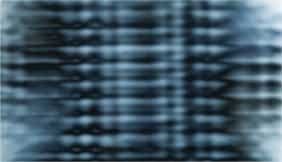
Final Conclusions
Glass shelves are visually pleasing because their transparency allows homeowners and interior designers to manipulate creative lighting effects by shining spotlights from above or below to illuminate your crystal or collectibles. Glass shelves blend into their environment, eliminating the heavy feel of a dark room.
These aesthetic advantages come with the responsibility of ensuring that they are securely installed so remember to put the safety of your family first and seek professional advice if you are uncertain about glass type, glass thickness, or shelf supports.
This post concludes that most residential shelving can be annealed and all commercial glass shelving should be tempered. See other posts for important information about glass color/tint, glass thickness, and glass edgework.
Glass tabletops & shelves – info from Artistry in Glass
- Benefits of glass shelving – info from experts!
- How much do glass tabletops cost?
- Do glass shelves need to be tempered?
- What is the best thickness for glass shelves?
- Best edge type for glass shelves, polished or beveled?
- How much weight can a wall shelf carry?
- What color glass should my shelves be?
- Glass tabletops – 10 amazing benefits explained
- How to order a glass tabletop
- Best thickness for glass tabletops – expert advice
- Should glass tabletops be tempered?
- Should glass tabletops be beveled?
- How to paint a glass tabletop
- All about tempering glass tabletops!
- How to tell if your glass is tempered
- Can tempered glass be cut?
- How to protect your wood table with glass
- How to fix a scratched glass tabletop
- How to fix a chipped glass tabletop
- How to replace broken patio table glass
- How to measure for a glass tabletop
- Video – how to measure your tabletop
- Plexiglass vs glass – pros and cons
- Beveled glass table base – a case study
- Choosing between tempered & laminated glass
- Glossary of terms used in the glass business
Artistry in Glass: your source for antique repair in Tucson
Check out these informative articles:-
- Where can I get antiques repaired?
- Are broken antiques worth fixing?
- How to fix a broken picture frame
- How to repair a broken china plate
- How to repair a broken china teapot
- How to fix a broken marble slab
- How to repair a broken china coffee mug
- How to repair a 2000-year-old sculpture
- All about repairing stained-glass lampshades
- How to care for your stained glass skylight
- How to repair Dalle de Verre
- Is stained glass worth repairing?
- To repair or toss out?
- What to do with broken antiques
- Is lead crystal dangerous?
- Repairing an antique Mexican statue
- Repairing religious statues
- The history of Swarovski crystal figurines
- How to find the value of a Swarovski Crystal figurine
- Have Swarovski figurines lost value since 2009?
- How to collect Swarovski annual ornaments
- How to display Swarovski crystal figurines
- How to authenticate a Swarovski crystal figurine
- How to display Swarovski annual ornaments
- How to clean Swarovski crystal figurines
- How to repair a Swarovski crystal mouse
- How to repair a Swarovski annual ornament
- How to repair a Swarovski crystal train set
- Fixing broken wine glass stems
- How to clean cloudy glasses
- Why do wine glasses have stems?
- Swarovski Crystal Figurines
- How to repair a chip in a wine glass
- How to fix a scratched glass tabletop
- How to replace a broken patio tabletop



